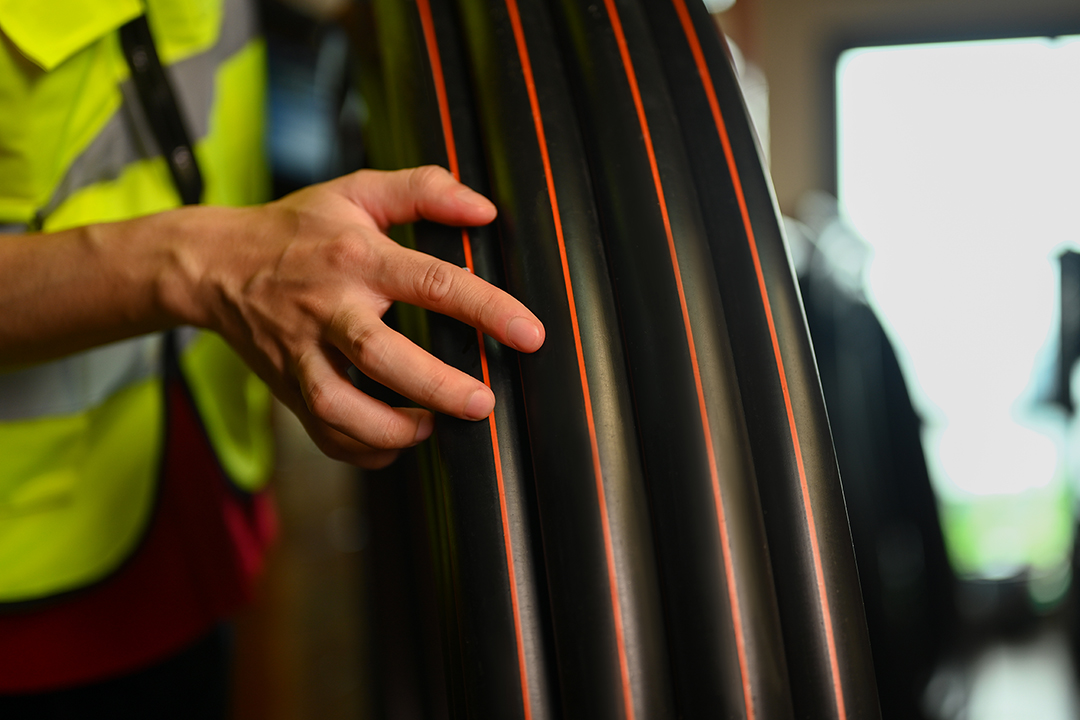ASTM F714 HDPE (High-Density Polyethylene) pipe is changing industrial infrastructure. It surpasses traditional materials like steel, concrete, and PVC in durability, chemical resistance, and cost-effectiveness. ASTM F714 HDPE pipe performs well in water treatment, chemical processing, mining, and oil and gas applications. Its use indicates a move towards efficient, reliable, and sustainable industrial practices.
What is ASTM F714 HDPE Pipe?
ASTM F714 is a standard specification for polyethylene (PE) plastic pipe based on outside diameter. This specification covers PE pipes with various dimension ratios (DR) and pressure ratings (PR). HDPE pipes manufactured to ASTM F714 standards offer exceptional performance characteristics that make them ideal for numerous industrial applications.
Key features of ASTM F714 HDPE pipe include:
- High strength-to-weight ratio;
- Excellent chemical resistance;
- Flexibility and impact resistance;
- Low friction coefficient;
- Long service life; and
- Corrosion resistance.
ASTM F714 HDPE Pipe vs. Traditional Materials
To fully appreciate the benefits of ASTM F714 HDPE pipe, it’s essential to compare it with traditional industrial materials such as steel, concrete, and PVC. Let’s examine how HDPE pipe stacks up against these conventional options in various aspects:
1. Durability and Longevity
ASTM F714 HDPE pipe outperforms many traditional materials in terms of durability and service life. While steel pipes are prone to corrosion and concrete pipes may crack or deteriorate over time, HDPE pipes resist corrosion, chemicals, and abrasion. This inherent durability translates to a longer service life, often exceeding 50 years with proper installation and maintenance.
The superior longevity of HDPE pipes results in reduced replacement costs and fewer service interruptions, making it a cost-effective choice for long-term industrial applications.
2. Chemical Resistance
Chemical resistance is a key advantage of ASTM F714 HDPE pipe in industrial settings with diverse chemical exposure. The Chemical resistance of HDPE allows these pipes to maintain their integrity when in contact with acids, bases, and other aggressive substances. While steel or concrete pipes may degrade in corrosive environments, HDPE pipes withstand a wide range of chemicals without compromising their performance.
This chemical resistance makes HDPE pipes ideal for applications in chemical processing plants, wastewater treatment facilities, and mining operations where exposure to harsh substances is common.
3. Flexibility and Impact Resistance
ASTM F714 HDPE pipe offers significant advantages in terms of flexibility and impact resistance compared to rigid materials like steel and concrete. The flexible nature of HDPE allows it to withstand ground movements, seismic activities, and heavy loads without cracking or breaking.
This flexibility also simplifies installation in challenging terrains or confined spaces. HDPE pipes can be bent to accommodate curves and obstacles, reducing the need for fittings and joints. The material’s ability to absorb impact and resist cracking makes it less susceptible to damage during transportation and installation.
4. Weight and Installation
One of the most significant advantages of ASTM F714 HDPE pipe over traditional materials is its lightweight nature. HDPE pipes weigh considerably less than steel or concrete pipes of similar dimensions, which offers several benefits:
- Easier handling and transportation;
- Reduced equipment requirements for installation;
- Lower labor costs; and
- Faster installation times.
The lightweight properties of HDPE pipes allow for more efficient and cost-effective installation processes, particularly in remote or challenging locations.
5. Hydraulic Performance
ASTM F714 HDPE pipe boasts superior hydraulic performance compared to many traditional materials. The smooth interior surface of HDPE pipes results in a low friction coefficient, which translates to improved flow characteristics and reduced pumping costs.
Over time, HDPE pipes maintain their smooth interior surface, unlike concrete or steel pipes which may develop roughness due to corrosion or mineral buildup. This sustained performance ensures consistent flow rates and energy efficiency throughout the pipe’s service life.
6. Joining Methods and Leak Resistance
HDPE pipes offer versatile joining methods, including heat fusion, electrofusion, and mechanical joining. Heat fusion, in particular, creates a homogeneous, leak-free joint that is as strong as the pipe itself. This joining method eliminates the need for gaskets or mechanical couplings, which are often weak points in traditional piping systems.
The leak-resistant nature of fused HDPE joints contributes to reduced maintenance costs, improved system reliability, and minimized environmental impact due to leakage.
Applications of ASTM F714 HDPE Pipe in Industrial Settings
The unique properties of ASTM F714 HDPE pipe make it suitable for a wide range of industrial applications. Some key areas where HDPE pipes have gained significant traction include:
1. Water and Wastewater Systems
HDPE pipes are increasingly used in water distribution networks and wastewater collection systems. Their corrosion resistance, leak-free joints, and long service life make them ideal for both potable water and sewage applications. HDPE pipes also resist the growth of biofilms, helping maintain water quality over time.
2. Chemical Processing and Transport
The exceptional chemical resistance of ASTM F714 HDPE pipe makes it a top choice for chemical processing industries. In these demanding environments, HDPE pipes excel at transporting a wide range of substances, from corrosive acids to caustic solutions. Chemical processing facilities benefit from HDPE’s ability to handle diverse chemical compounds without degradation, ensuring safe and efficient operations throughout the production cycle.
3. Mining and Slurry Transport
In mining operations, HDPE pipes are used for transporting abrasive slurries and tailings. The pipe’s wear resistance and flexibility allow it to withstand the demanding conditions of mining environments, including high pressures and abrasive materials.
4. Oil and Gas Industry
HDPE pipes are used in various aspects of the oil and gas industry, including:
- Gathering lines for produced water and oil;
- Flowlines for well production;
- Water injection lines; and
- Secondary containment systems.
The pipes’ resistance to hydrocarbons and ability to withstand high pressures make them suitable for these demanding applications.
5. Industrial Cooling Systems
HDPE pipes are used in industrial cooling systems due to their resistance to corrosion and scaling. They maintain their performance over time, ensuring efficient heat transfer and reducing maintenance requirements.
Considerations for Implementing ASTM F714 HDPE Pipe
While ASTM F714 HDPE pipe offers numerous advantages, there are several factors to consider when implementing this material in industrial applications:
1. Temperature Limitations
HDPE pipes have temperature limitations and may not be suitable for extremely high-temperature applications. It’s essential to consider the operating temperature range of the specific HDPE grade and ensure it meets the requirements of the intended application.
2. Pressure Ratings
ASTM F714 HDPE pipes are available in various pressure ratings. It’s crucial to select the appropriate dimension ratio (DR) and pressure class for the specific application to ensure safe and reliable operation.
3. UV Exposure
While HDPE pipes have good resistance to UV radiation, prolonged exposure can affect their properties. For above-ground applications, it may be necessary to use UV-stabilized HDPE or provide additional protection.
4. Installation Expertise
Proper installation is critical to realizing the full benefits of ASTM F714 HDPE pipe. Installers should be trained in appropriate joining methods, particularly heat fusion techniques, to ensure the integrity of the piping system.
5. Regulatory Compliance
When implementing HDPE pipes in industrial applications, it’s essential to ensure compliance with relevant industry standards and regulations. This may include standards related to material properties, testing requirements, and installation practices.
Coastal Resource Group: Your ASTM F714 HDPE Pipe Supplier
Implementing ASTM F714 HDPE pipe requires a reliable supplier like Coastal Resource Group. We offer:
- High-quality ASTM F714 HDPE pipes and fittings;
- Expert advice on selection and application;
- Fast delivery to maintain project timelines;
- Wide range of industrial supplies; and
- 24/7 availability for emergencies.
Our expertise and commitment to service make us an ideal partner for businesses adopting ASTM F714 HDPE pipe. Our quick, dependable supply chain supports the efficient implementation of these innovative piping solutions across various industries. Contact us today to learn how we can help you with your plastic piping needs.


